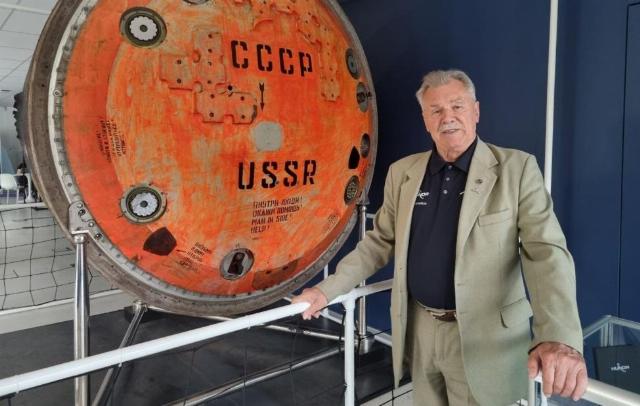Bertalan Farkas said that he intends to organize such a meeting at the end of July.
BUDAPEST, May 23. /TASS correspondent Ivan Lebedev/. Bertalan Farkas, the first and so far the only Hungarian cosmonaut, plans to gather in Budapest all his colleagues from other countries who participated in the Soviet Intercosmos program in the 1970s and 1980s. In an interview with a TASS correspondent, he said that he intends to organize such a meeting at the end of July.
"The Intercosmos program was a great idea of the Soviet government, which allowed other socialist countries to literally rise to cosmic heights. The program was successfully completed, and all the astronauts returned to Earth," recalled Farkash, who is now celebrating the 45th anniversary of his flight to the Salyut-6 space station.
Farkas noted with sadness that many participants of the Intercosmos program are no longer there. Kubasov and Ryumin, the Pole Miroslav Germashevsky and the German Sigmund Yen passed away. "I want to gather those who are still alive. My friends in Moscow said: "Come on, Berzi, this is a great idea," said Farkas.
He was the fifth cosmonaut from socialist countries to participate in the Intercosmos program, following colleagues from Czechoslovakia, Poland, the GDR and Bulgaria. Farkash set off on a flight on the Soviet Soyuz-36 spacecraft with Valery Kubasov on May 26 and returned to Earth on June 3, 1980. During a week of work at the station, where they were met by Valery Ryumin and Leonid Popov, he conducted a dozen and a half scientific and medical experiments, including using Hungarian instruments and equipment.
The Intercosmos program was an important step towards broad international cooperation in the space field. In addition to the Soviet Union, Bulgaria, Hungary, Vietnam, the GDR, Cuba, Mongolia, Poland, Romania, and Czechoslovakia took part in it. The first manned flight under this program took place in March 1978, when Vladimir Remek, a citizen of Czechoslovakia, went to the Salyut-6 station on the Soyuz-28 spacecraft.
The first acquaintance
Farkash remembers with pleasure all the astronauts with whom he had the opportunity to work in space and on earth. The first of them he had to meet was Peter Klimuk, who came to the Hungarian Air Force base in Papa in the mid-1970s to look at possible cosmonaut candidates.
Farkas, who had graduated from flight schools in Hungary and the Soviet Union by that time, served there with the rank of senior lieutenant. Since he knew Russian, the command instructed him to make a short report on the military unit for the important guest. After finishing it, the young officer added from himself that if the Soviet government ever gave the Hungarian pilot the opportunity to go into space, he would like to make such a trip.
According to him, it was not coordinated with the command of the unit, but, apparently, Klimuk liked it. And then life turned out so that three years later they met in Star City as old acquaintances and Farkash began training in the cosmonaut squad. Klimuk told him at the meeting: "Well, you said then that you wanted to fly."
Cooperation for space exploration
Farkas is convinced that further space exploration is impossible without broad international cooperation. "It will be impossible to do without it when flying to the Moon and even further to Mars," the expert noted.
"Hungary participates in the work of the European Space Agency (ESA) and is interested in international cooperation. There are very serious tasks and goals," Farkas said.
According to him, there are also opportunities for resuming active cooperation in the space field between Hungary and Russia. However, the future direction of the Hungarian space program will be determined after the flight of Hungarian engineer Tibor Kapu.
He is scheduled to travel to the International Space Station (ISS) on June 8 aboard the Dragon spacecraft, which will be launched into orbit by SpaceX's Falcon 9 launch vehicle. American astronaut Peggy Whitson has been appointed commander of the spacecraft, and the crew also includes Indian test pilot Shubhanshu Shukla and ESA astronaut Slavosh Uznansky.
Kapu passed a competitive selection and became a candidate for a flight to the ISS under an agreement with NASA and the American company Axiom Space, which is engaged in space tourism. He will spend 30 days at the station and perform scientific experiments according to a program compiled by Hungarian universities and research centers. Farkas is glad that another Hungarian citizen is preparing to go into space.
The conversation with the first Hungarian cosmonaut took place at an exhibition that opened in Budapest in connection with the 45th anniversary of his flight and the upcoming Kapu journey. The interactive exhibition, which tells about the history of space exploration and the Hungarian space program, includes, in addition to models of orbital stations and ships, several original exhibits. Among them are Farkash's space suit and the Soyuz-35 lander, in which he and Kubasov returned to Earth.
An emergency situation occurred during the landing of the vehicle. The altimeter system did not work and did not issue a command to start the soft landing engines. The shock absorbers of the seats absorbed the energy of the impact, and the crew experienced maximum permissible overloads. After flying into space, Farkas became a Hero of the Hungarian People's Republic and a Hero of the Soviet Union, and was promoted to the rank of Brigadier General of the Air Force.

